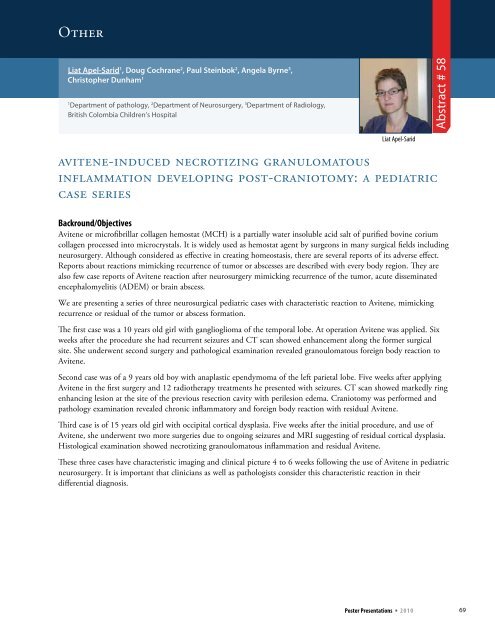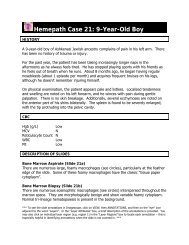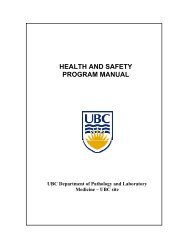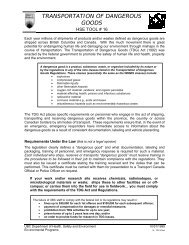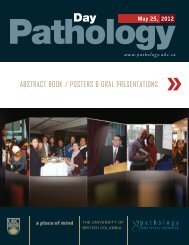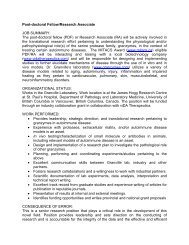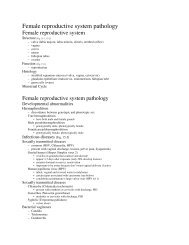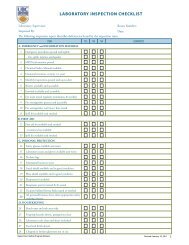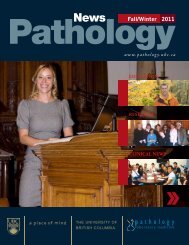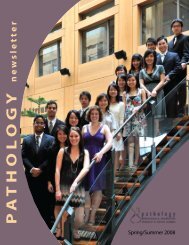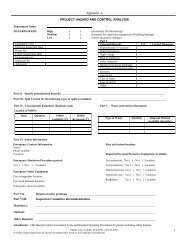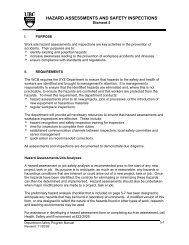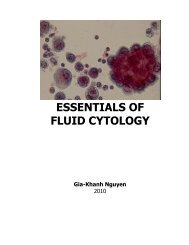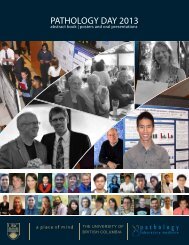OtherAbstract # 57Tak Kwong Poon 1 , Jerry Wong 1 , John Zhang 1 , Guang Gao 1 , Honglin Luo 11The James Hogg iCAPTURE Centre, Department of <strong>Pathology</strong> <strong>and</strong> <strong>Laboratory</strong> <strong>Medicine</strong>,<strong>University</strong> of British Columbia, Providence Heart + Lung Institute, St. Paul’s Hospital,Vancouver, British Columbia, Canada.Tak Poonthe role of eukaryotic translation initiation factor2 alpha related pathways in autophagosome formationduring Coxsackievirus B3 induced myocarditisBackround/ObjectivesCoxsackievirus B3 (CVB3) is one of the predominant strains of viruses causing myocarditis, which is the inflammationof the cardiac muscles. Such inflammation can reduce the ability of the heart to pump blood <strong>and</strong> may lead to dilatedcardiomyophathy, a potentially lethal disorder with few treatment options. Autophagy is a cellular process by whichorganelles <strong>and</strong> proteins are isolated by double membrane vesicles (autophagosomes) <strong>and</strong> degraded following fusionwith lysosomes. Previous studies have shown that CVB3 is able to up-regulate the formation of autophagosomes <strong>and</strong>utilize these double-membrane structures for more effective replication of viruses. In this study, we aim to: (1) identifythe host signalling pathways which are helping in the formation of autophagosomes through eIF2alpha; (2) examinethe role of autophagy in CVB3-induced myocarditis using an autophagy defective transgenic mouse model. It hasbeen reported that CVB3 infection leads to an increase in the phosphorylation of eukaryotic initiation factor 2 alpha(eIF2alpha), a protein found to positively regulate pathways controlling autophagy. Two notable upstream kinases ofeIF2alpha are: PRKR-like endoplasmic reticulum kinase (PERK) found to be activated under endoplasmic reticulumstress <strong>and</strong> Protein kinase RNA-activated (PKR) activated upon detection of double str<strong>and</strong>ed RNA in cells.MethodsFollowing CVB3 or Mock infection of Human Embryonic Kidney 293A (HEK293A) cells for 4, 8, <strong>and</strong> 12 hours,cell lysates were collected for Western blot analysis of the phosphorylation status of PERK, PKR, eIF2alpha. Shortinterfering RNAs (siRNAs) targeting against PERK, PKR <strong>and</strong> eIF2alpha were used to determine the effects ofblocking the pathways on autophagosome formation. Mice with GFP labeled microtubule-associated protein 1 lightchain 3 (GFP-LC3), a marker of autophagosome formation, will be used to monitor the effect ofCVB3 infectionof mice on autophagy. Moreover, mice with tamoxifen inducible cardiac specific knockout of autophagy relatedgene 7 (ATG7) will be generated to examine the effect of preventing autophagosome formation on CVB3-inducedmyocarditis.ResultsStarting from 4 hours post-CVB3 infection, an increase in the phosphorylation of PERK relative to mock infection,was observed. eIF2alpha phosphorylation was found to be increased after 8 hours of viral infection <strong>and</strong> furtherincreased at 12 hours post-infection. PKR phosphorylation levels remained constant during the infection time points;however total protein levels of PKR were decreased after 12 hours of viral infection. To generate cardiac-specificATG7 conditional knockout mice, we crossed ATG7 floxed-allele mice with inducible cardiac-specific Cre mice fromwhich we obtained progeny for further breeding. GFP-LC3 mice were successfully mated to generate offspring.ConclusionPhosphorylation of PERK was increased following CVB3 infection, which may play a role in CVB3-inducedautophagosome formation via activating eIF2alpha. We are in the process of generating the cardiac-specific ATG7knockout mice as well as the GFP-LC3 mice to be used for experimental purposes.68 2 0 1 0 * P o s t e r P r e s e n t a t i o n s
OtherLiat Apel-Sarid 1 , Doug Cochrane 2 , Paul Steinbok 2 , Angela Byrne 3 ,Christopher Dunham 11Department of pathology, 2 Department of Neurosurgery, 3 Department of Radiology,British Colombia Children’s HospitalAbstract # 58Liat Apel-Saridavitene-induced necrotizing granulomatousinflammation developing post-craniotomy: a pediatriccase seriesBackround/ObjectivesAvitene or microfibrillar collagen hemostat (MCH) is a partially water insoluble acid salt of purified bovine coriumcollagen processed into microcrystals. It is widely used as hemostat agent by surgeons in many surgical fields includingneurosurgery. Although considered as effective in creating homeostasis, there are several reports of its adverse effect.Reports about reactions mimicking recurrence of tumor or abscesses are described with every body region. They arealso few case reports of Avitene reaction after neurosurgery mimicking recurrence of the tumor, acute disseminatedencephalomyelitis (ADEM) or brain abscess.We are presenting a series of three neurosurgical pediatric cases with characteristic reaction to Avitene, mimickingrecurrence or residual of the tumor or abscess formation.The first case was a 10 years old girl with ganglioglioma of the temporal lobe. At operation Avitene was applied. Sixweeks after the procedure she had recurrent seizures <strong>and</strong> CT scan showed enhancement along the former surgicalsite. She underwent second surgery <strong>and</strong> pathological examination revealed granoulomatous foreign body reaction toAvitene.Second case was of a 9 years old boy with anaplastic ependymoma of the left parietal lobe. Five weeks after applyingAvitene in the first surgery <strong>and</strong> 12 radiotherapy treatments he presented with seizures. CT scan showed markedly ringenhancing lesion at the site of the previous resection cavity with perilesion edema. Craniotomy was performed <strong>and</strong>pathology examination revealed chronic inflammatory <strong>and</strong> foreign body reaction with residual Avitene.Third case is of 15 years old girl with occipital cortical dysplasia. Five weeks after the initial procedure, <strong>and</strong> use ofAvitene, she underwent two more surgeries due to ongoing seizures <strong>and</strong> MRI suggesting of residual cortical dysplasia.Histological examination showed necrotizing granoulomatous inflammation <strong>and</strong> residual Avitene.These three cases have characteristic imaging <strong>and</strong> clinical picture 4 to 6 weeks following the use of Avitene in pediatricneurosurgery. It is important that clinicians as well as pathologists consider this characteristic reaction in theirdifferential diagnosis.Poster <strong>Presentations</strong> * 2 0 1 069
- Page 2:
PathDay: Keynote Speaker (4:30 pm)T
- Page 5:
Conference Outline2010abstract #14
- Page 9 and 10:
Table of Contentabstract #57 The ro
- Page 11 and 12:
ResidentClinical SciencesArwa Al-Ri
- Page 13 and 14:
ResidentTitus Wong 1 , Marc Romney,
- Page 17 and 18: ResidentD. Turbin 1 , D. Gao 2 , J.
- Page 19 and 20: ResidentDavid F Schaeffer 1 , Eric
- Page 21 and 22: ResidentMajid Zolein 1 , Daniel T.
- Page 23 and 24: Graduate StudentAshish K. Marwaha 1
- Page 25 and 26: Graduate StudentAmanda Vanden Hoek
- Page 27 and 28: Graduate StudentXin Ye 1 , Mary Zha
- Page 29: Graduate StudentLisa S. Ang 1 , Sar
- Page 32 and 33: Graduate StudentAbstract # 22Brian
- Page 36 and 37: OtherAbstract # 25Crystal Leung, Li
- Page 38 and 39: OtherAbstract # 27Lise Matzke 1 , W
- Page 40 and 41: Graduate StudentAbstract # 29Varun
- Page 42 and 43: Graduate StudentAbstract # 31Maite
- Page 44 and 45: Post-doctoral FellowAbstract # 33Ra
- Page 46 and 47: Graduate StudentAbstract # 35Hayley
- Page 48: Post-doctoral FellowAbstract # 37Es
- Page 51 and 52: ResidentAhmad Al-Sarraf MD 1, 2 , G
- Page 53 and 54: OtherRebecca Towle 1 , Danielle Mac
- Page 55 and 56: Graduate StudentPaul R. Hiebert 1,2
- Page 57 and 58: Graduate StudentV. Montoya 1 , J. G
- Page 59 and 60: OtherWalter Martz and Henry Kalicia
- Page 61 and 62: OtherKatelyn J. Janzen 1 , Elizabet
- Page 63 and 64: Graduate StudentJasmine L. Hamilton
- Page 65 and 66: Graduate StudentIan M. Wilson 1 , K
- Page 67: Graduate StudentKelsie L. Thu 1,3 ,
- Page 71 and 72: Graduate StudentJennifer R. Choo 1,
- Page 73 and 74: Graduate StudentEdwin S. Gershom 1
- Page 75 and 76: OtherYing Qiao 1, 2 , Chansonette H
- Page 77 and 78: Graduate StudentLeslie YM Chin 1,4
- Page 79 and 80: Graduate StudentBillie Velapatiño
- Page 81 and 82: Graduate StudentSophie Stukas 1 , S
- Page 83 and 84: Graduate StudentKyluik DL and Scott
- Page 85 and 86: Post-doctoral FellowJoel Montane 1
- Page 87 and 88: IndexAAbozina A. 45Abraham T. 55All
- Page 89: Ye X. 27, 82Yee S. 31Yoshida E. 12Y


